七年级英语下集体备课教案unit9
- 格式:doc
- 大小:109.50 KB
- 文档页数:8
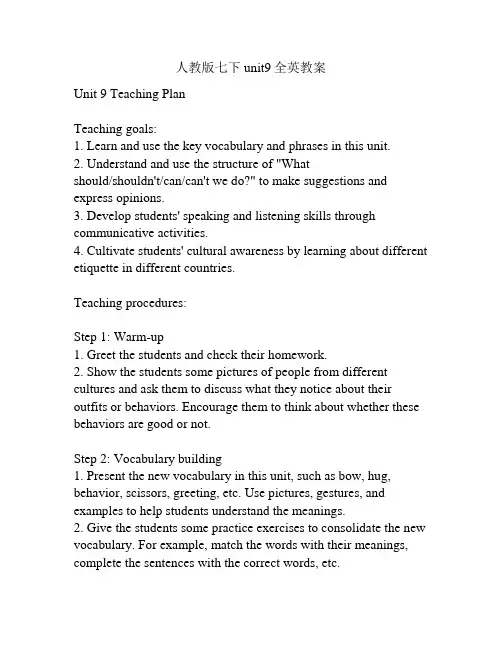
人教版七下unit9全英教案Unit 9 Teaching PlanTeaching goals:1. Learn and use the key vocabulary and phrases in this unit.2. Understand and use the structure of "Whatshould/shouldn't/can/can't we do?" to make suggestions and express opinions.3. Develop students' speaking and listening skills through communicative activities.4. Cultivate students' cultural awareness by learning about different etiquette in different countries.Teaching procedures:Step 1: Warm-up1. Greet the students and check their homework.2. Show the students some pictures of people from different cultures and ask them to discuss what they notice about their outfits or behaviors. Encourage them to think about whether these behaviors are good or not.Step 2: Vocabulary building1. Present the new vocabulary in this unit, such as bow, hug, behavior, scissors, greeting, etc. Use pictures, gestures, and examples to help students understand the meanings.2. Give the students some practice exercises to consolidate the new vocabulary. For example, match the words with their meanings, complete the sentences with the correct words, etc.Step 3: Reading and listening1. Have the students read the text "Etiquette around the world" silently and underline the key information. Then discuss in pairs about what they have learned.2. Play the listening material for the students to listen and match the countries with their customs. After listening, check the answers with the whole class.Step 4: Speaking practice1. Divide the students into groups and have them discuss the questions in Activity 3 on page 64. Encourage them to express their opinions and give reasons for their choices.2. Role play: Have the students work in pairs and act out a conversation where they make suggestions about etiquette in different situations. For example, one student can be a visitor and the other can be a local person. They can discuss what the visitor should or shouldn't do.3. Group presentation: Assign each group a country and have them research and present on the etiquette customs in that country. They can use pictures, videos, and real-life examples to make their presentations more engaging.Step 5: Consolidation1. Have the students complete the exercises in the workbook to consolidate what they have learned in this unit.2. Review the key vocabulary and phrases with the students. Play some vocabulary review games, such as "Taboo", "Hot Seat", or "Charades".Step 6: Assessment1. Give the students a quiz to test their understanding of the vocabulary and grammar in this unit.2. Evaluate the students' speaking and presentation skills based on their performance in the role play and group presentation activities. Step 7: Homework1. Assign homework exercises from the workbook to reinforce what they have learned in this unit.2. Ask the students to write a short essay about their own culture's etiquette customs, comparing and contrasting them with those in other countries.。
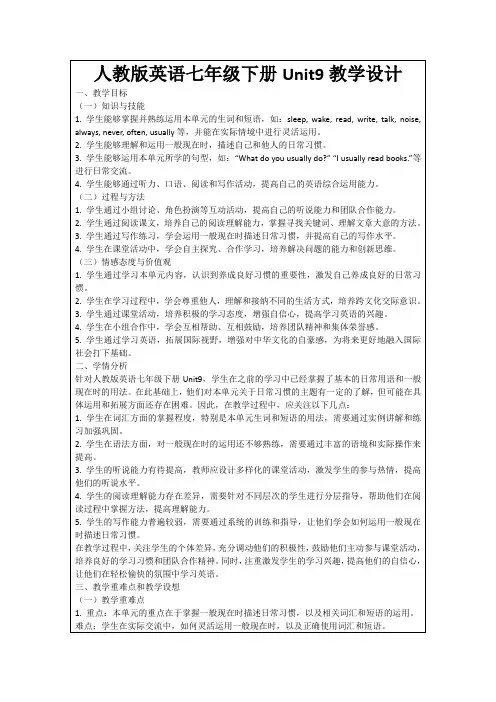
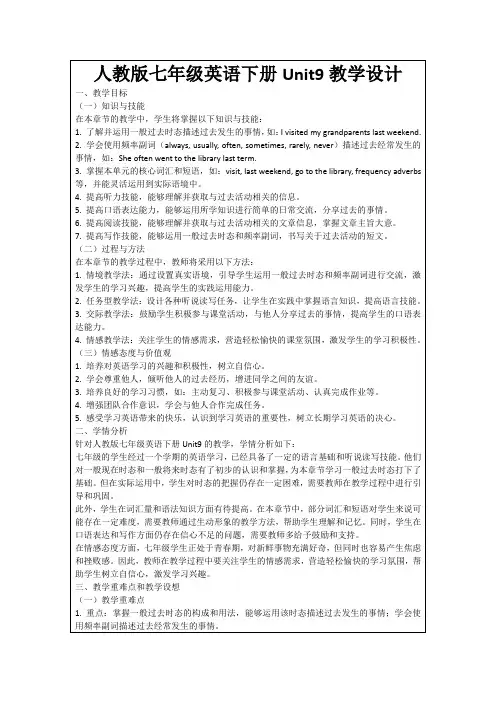
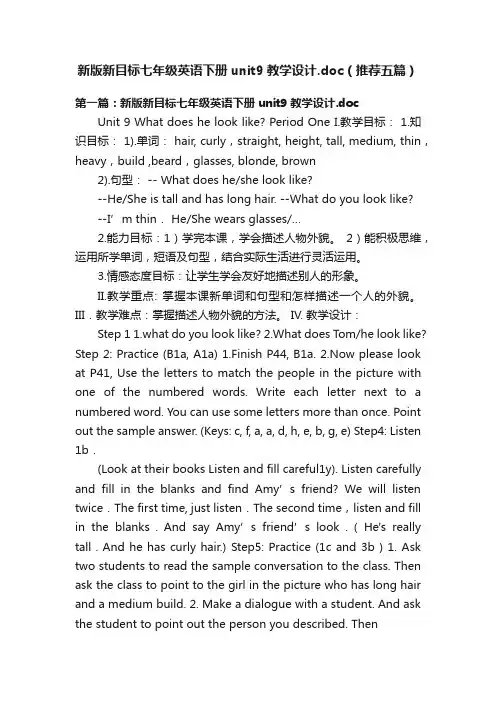
新版新目标七年级英语下册unit9教学设计.doc(推荐五篇)第一篇:新版新目标七年级英语下册unit9教学设计.docUnit 9 What does he look like? Period One I.教学目标: 1.知识目标: 1).单词: hair, curly,straight, height, tall, medium, thin,heavy,build ,beard,glasses, blonde, brown2).句型: -- What does he/she look like?--He/She is tall and has long hair. --What do you look like?--I’m thin.He/She wears glasses/…2.能力目标:1)学完本课,学会描述人物外貌。
2)能积极思维,运用所学单词,短语及句型,结合实际生活进行灵活运用。
3.情感态度目标:让学生学会友好地描述别人的形象。
II.教学重点: 掌握本课新单词和句型和怎样描述一个人的外貌。
III.教学难点:掌握描述人物外貌的方法。
IV. 教学设计:Step 1 1.what do you look like? 2.What does Tom/he look like? Step 2: Practice (B1a, A1a) 1.Finish P44, B1a. 2.Now please look at P41, Use the letters to match the people in the picture with one of the numbered words. Write each letter next to a numbered word. You can use some letters more than once. Point out the sample answer. (Keys: c, f, a, a, d, h, e, b, g, e) Step4: Listen 1b.(Look at their books Listen and fill careful1y). Listen carefully and fill in the blanks and find Amy’s friend? We will listen twice.The first time, just listen.The second time,listen and fill in the blanks.And say Amy’s friend’s look.( He's really tall.And he has curly hair.) Step5: Practice (1c and 3b ) 1. Ask two students to read the sample conversation to the class. Then ask the class to point to the girl in the picture who has long hair and a medium build. 2. Make a dialogue with a student. And ask the student to point out the person you described. ThenSs practice the dialogue in pairs. 3.(3b) 1). 2). Act the dialogue. 3). Finish the form. Step 6 make sentences (Section B 1b) Step 7 describe(shelfcheck3) Step 8 a guessing game (SectionB2c) Step9 homework Describe your family member and draw a picture of him/her.Period TwoI.教学目标: 1.知识目标: 1).单词:always, captain, popular,team, good-looking, a little bit, joke, never, stop, teeny, huge, dreamer, wise 2).句型:如同第一课时。
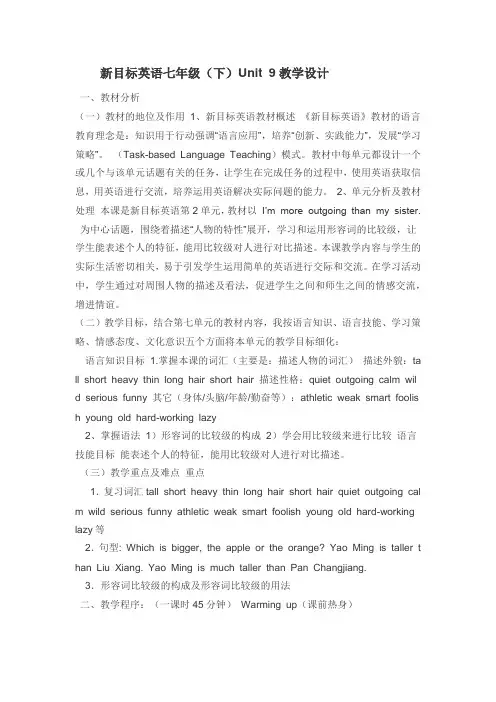
新目标英语七年级(下)Unit 9教学设计一、教材分析(一)教材的地位及作用1、新目标英语教材概述《新目标英语》教材的语言教育理念是:知识用于行动强调“语言应用”,培养“创新、实践能力”,发展“学习策略”。
(Task-based Language Teaching)模式。
教材中每单元都设计一个或几个与该单元话题有关的任务,让学生在完成任务的过程中,使用英语获取信息,用英语进行交流,培养运用英语解决实际问题的能力。
2、单元分析及教材处理本课是新目标英语第2单元,教材以I’m more outgoing than my sister.为中心话题,围绕着描述“人物的特性”展开,学习和运用形容词的比较级,让学生能表述个人的特征,能用比较级对人进行对比描述。
本课教学内容与学生的实际生活密切相关,易于引发学生运用简单的英语进行交际和交流。
在学习活动中,学生通过对周围人物的描述及看法,促进学生之间和师生之间的情感交流,增进情谊。
(二)教学目标,结合第七单元的教材内容,我按语言知识、语言技能、学习策略、情感态度、文化意识五个方面将本单元的教学目标细化:语言知识目标1.掌握本课的词汇(主要是:描述人物的词汇)描述外貌:ta ll short heavy thin long hair short hair 描述性格:quiet outgoing calm wil d serious funny 其它(身体/头脑/年龄/勤奋等):athletic weak smart foolish young old hard-working lazy2、掌握语法1)形容词的比较级的构成2)学会用比较级来进行比较语言技能目标能表述个人的特征,能用比较级对人进行对比描述。
(三)教学重点及难点重点1.复习词汇tall short heavy thin long hair short hair quiet outgoing cal m wild serious funny athletic weak smart foolish young old hard-working lazy等2.句型: Which is bigger, the apple or the orange? Yao Ming is taller t han Liu Xiang. Yao Ming is much taller than Pan Changjiang.3.形容词比较级的构成及形容词比较级的用法二、教学程序:(一课时45分钟)Warming up(课前热身)1. Read the tongue twister quickly. 通过快速读出绕口令,培养学生的语感。
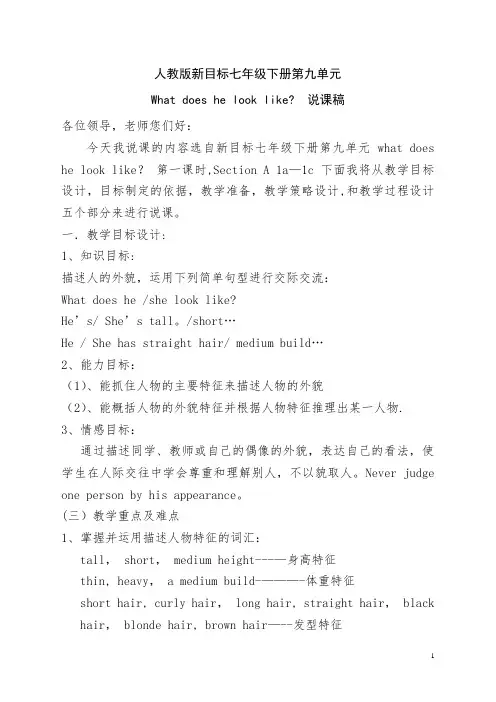
人教版新目标七年级下册第九单元What does he look like? 说课稿各位领导,老师您们好:今天我说课的内容选自新目标七年级下册第九单元 what does he look like?第一课时,Section A 1a—1c 下面我将从教学目标设计,目标制定的依据,教学准备,教学策略设计,和教学过程设计五个部分来进行说课。
一.教学目标设计:1、知识目标:描述人的外貌,运用下列简单句型进行交际交流:What does he /she look like?He’s/ She’s tall。
/short…He / She has straight hair/ medium build…2、能力目标:(1)、能抓住人物的主要特征来描述人物的外貌(2)、能概括人物的外貌特征并根据人物特征推理出某一人物.3、情感目标:通过描述同学、教师或自己的偶像的外貌,表达自己的看法,使学生在人际交往中学会尊重和理解别人,不以貌取人。
Never judge one person by his appearance。
(三)教学重点及难点1、掌握并运用描述人物特征的词汇:tall, short, medium height---—身高特征thin, heavy, a medium build-———-体重特征short hair, curly hair, long hair, straight hair, black hair, blonde hair, brown hair—--发型特征2、掌握并运用简单的英语交际句型:Is that your friend?No, it isn’t。
What does he/ she look like?He / She is…。
. /has…Do you know ….?No, what does he / she look like?3.难点:1)描述头发时形容词的排列顺序:长短+形状+颜色2)注意比较动词“has"和“is”在对人物进行描述时的用法及汉语意思的差别。
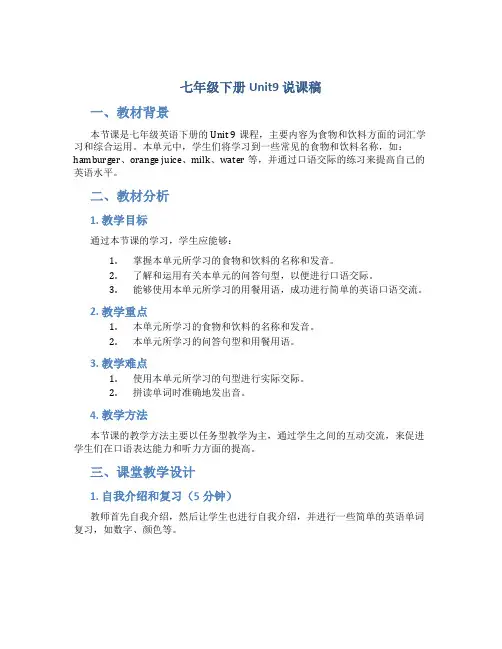
七年级下册Unit9 说课稿一、教材背景本节课是七年级英语下册的Unit 9课程,主要内容为食物和饮料方面的词汇学习和综合运用。
本单元中,学生们将学习到一些常见的食物和饮料名称,如:hamburger、orange juice、milk、water等,并通过口语交际的练习来提高自己的英语水平。
二、教材分析1. 教学目标通过本节课的学习,学生应能够:1.掌握本单元所学习的食物和饮料的名称和发音。
2.了解和运用有关本单元的问答句型,以便进行口语交际。
3.能够使用本单元所学习的用餐用语,成功进行简单的英语口语交流。
2. 教学重点1.本单元所学习的食物和饮料的名称和发音。
2.本单元所学习的问答句型和用餐用语。
3. 教学难点1.使用本单元所学习的句型进行实际交际。
2.拼读单词时准确地发出音。
4. 教学方法本节课的教学方法主要以任务型教学为主,通过学生之间的互动交流,来促进学生们在口语表达能力和听力方面的提高。
三、课堂教学设计1. 自我介绍和复习(5分钟)教师首先自我介绍,然后让学生也进行自我介绍,并进行一些简单的英语单词复习,如数字、颜色等。
2. 学习新单词(10分钟)教师向学生介绍新单词,包括食物和饮料的名称,通过发音让学生正确地读出单词并理解其含义。
3. 句型表达(20分钟)教师通过问答方式,让学生掌握本单元所学的句型及其用法。
同时,教师还可以向学生介绍一些常用的用餐用语。
4. 交际练习(30分钟)教师将学生分成小组,让学生之间进行一些真实场景的练习,如在餐厅点餐、购物时购买食物等。
通过互相交流、模仿和纠正,学生可以更好地熟悉掌握所学内容,并提高英语口语表达能力。
5. 归纳总结(10分钟)教师通过总结本节课所学内容,让学生掌握本单元中重点难点知识点,并巩固所学内容。
四、教学建议1.在教授新单词和句型时,教师可以使用音频、图片等资源,帮助学生更好地理解和记忆所学内容。
2.在进行交际练习时,教师应根据学生的实际情况和英语水平,分成不同程度的小组,以保证每个学生都能够得到适当的提高。
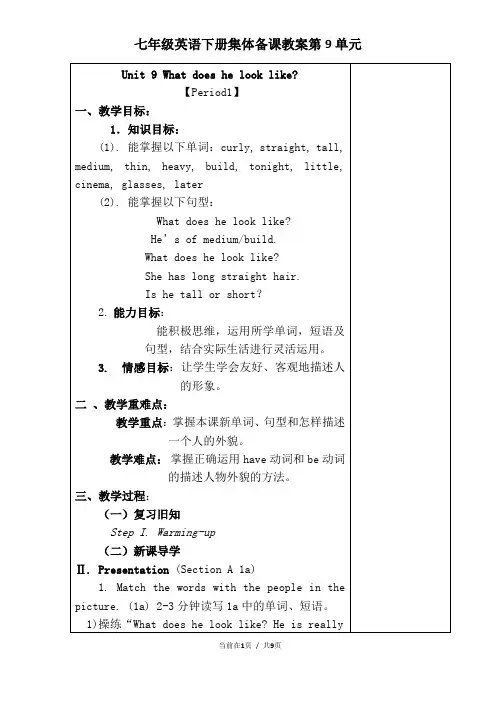
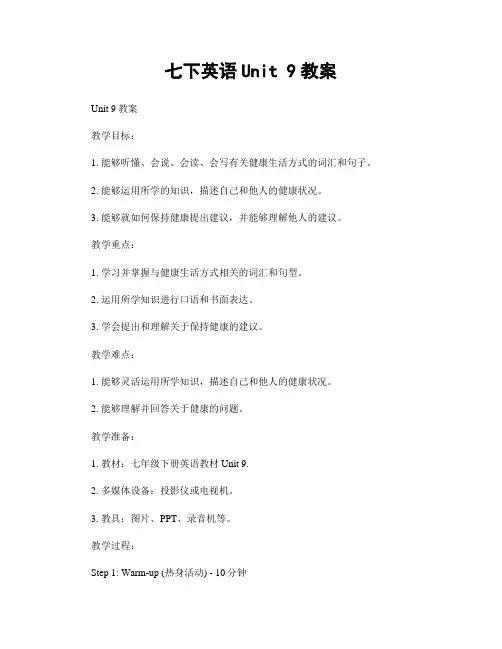
七下英语Unit 9教案Unit 9教案教学目标:1. 能够听懂、会说、会读、会写有关健康生活方式的词汇和句子。
2. 能够运用所学的知识,描述自己和他人的健康状况。
3. 能够就如何保持健康提出建议,并能够理解他人的建议。
教学重点:1. 学习并掌握与健康生活方式相关的词汇和句型。
2. 运用所学知识进行口语和书面表达。
3. 学会提出和理解关于保持健康的建议。
教学难点:1. 能够灵活运用所学知识,描述自己和他人的健康状况。
2. 能够理解并回答关于健康的问题。
教学准备:1. 教材:七年级下册英语教材 Unit 9.2. 多媒体设备:投影仪或电视机。
3. 教具:图片、PPT、录音机等。
教学过程:Step 1: Warm-up (热身活动) - 10分钟1. 通过展示一些健康相关的图片,引发学生对健康生活方式的讨论。
2. 让学生用英语表达自己的健康状况,并与同桌分享。
Step 2: Presentation (呈现新知) - 15分钟1. 呈现并教授新的词汇和句型,如healthy, unhealthy, exercise, eat a balanced diet, etc.2. 通过图片和实物,让学生理解和记忆新的词汇和句型。
3. 利用多媒体设备播放相关视频或录音,帮助学生更好地理解课文内容。
Step 3: Practice (练习) - 20分钟1. 进行口语练习,让学生以小组为单位,就自己和他人的健康状况进行对话。
2. 学生可以根据所学的词汇和句型,提出问题并回答问题。
3. 教师可以在练习过程中给予学生适当的指导和帮助。
Step 4: Consolidation (巩固) - 15分钟1. 让学生用所学的知识,撰写一篇关于健康生活方式的短文。
2. 学生可以结合自己的生活经验和所学的词汇和句型,描述自己的健康状况以及保持健康的方法。
3. 学生可以在小组内互相交流和修改自己的短文,提高写作水平。
Step 5: Extension (拓展) - 15分钟1. 分享学生的短文,让其他同学进行评价和提出建议。
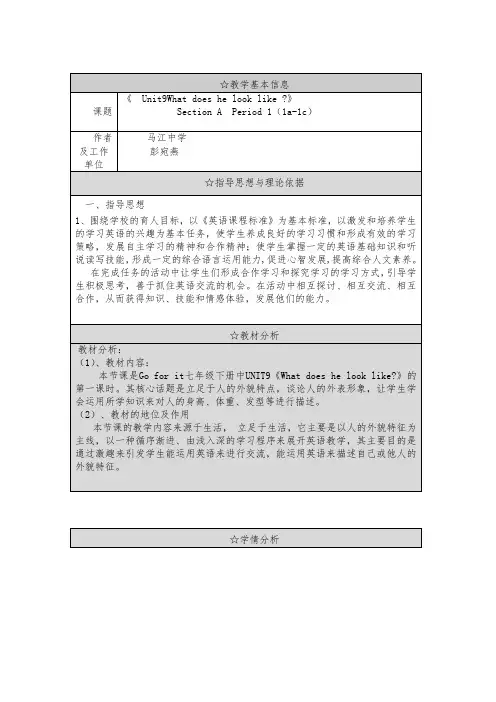
☆教学过程Step I 导入 Leading-inT: All of you are my good friends. But who is my best friend in your class?(你们大家都是我的好朋友,但谁是我最好的朋友?你们猜。
)学生开始激动了,几乎全班的小手都举起来了。
一学生问:S1: Is your best friend a boy or a girl?T: A boyAsk a boy who is short and fat to act as Pan Chang-jiang with a toy gun. Tell students: He is my best friend。
What does he look like? Let students understand the words . He has short hair.He is short .He is heavy/fat.(设计意图:1用学生表演导入目的是为了拉近师学间的距离,与学生交朋友建立平等的学习关系,提高学习英语的英趣,建立一个良好的学习氛围。
2,为描述朋友及家人的外貌活动的作业作好铺垫。
)Step II Presentation:1、课件展示开始了本课的教学内容。
1.Show a pictures and describe about their height / build / hairstyles . Let students understand the words in the class . e g: short /long/ no hair ; tall / short / medium height ; fat ( heavy)/ thin / medium build.2、 Watch a Videw.ask students What does he look like ?Can you draw yours your friend’s picture?. 展示照片,让学生通过观察后能互相提问并描述出其外貌特征On the photo of family ,point out the teacher wants to have a new look and asks students to choose a hairstyle to fit .Teach some new knowledge about hairstyle and write them on the Bb: What does she/ he look like?She / He has short hair / straight hair / curly hair / long hair .3、Let students design new hairstyle, then tell students the teacher ’s choice : “I want to have the same hairstyle as Zhao Wei.” Finally show the photo of Zhao Wei, the practice and point :What does she look like ?She has long straight black hair .(设计意图:通过对老师新形象设计的想象,提高学生的审美力,加强对发型设计的词汇的掌握且板书。
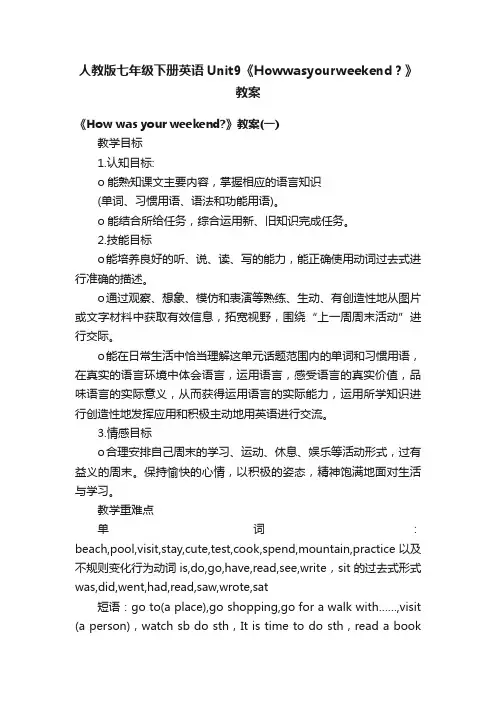
人教版七年级下册英语Unit9《Howwasyourweekend?》教案《How was your weekend?》教案(一)教学目标1.认知目标:o能熟知课文主要内容,掌握相应的语言知识(单词、习惯用语、语法和功能用语)。
o能结合所给任务,综合运用新、旧知识完成任务。
2.技能目标o能培养良好的听、说、读、写的能力,能正确使用动词过去式进行准确的描述。
o通过观察、想象、模仿和表演等熟练、生动、有创造性地从图片或文字材料中获取有效信息,拓宽视野,围绕“上一周周末活动”进行交际。
o能在日常生活中恰当理解这单元话题范围内的单词和习惯用语,在真实的语言环境中体会语言,运用语言,感受语言的真实价值,品味语言的实际意义,从而获得运用语言的实际能力,运用所学知识进行创造性地发挥应用和积极主动地用英语进行交流。
3.情感目标o合理安排自己周末的学习、运动、休息、娱乐等活动形式,过有益义的周末。
保持愉快的心情,以积极的姿态,精神饱满地面对生活与学习。
教学重难点单词:beach,pool,visit,stay,cute,test,cook,spend,mountain,practice以及不规则变化行为动词is,do,go,have,read,see,write,sit的过去式形式was,did,went,had,read,saw,wrote,sat短语:go to(a place),go shopping,go for a walk with……,visit (a person),watch sb do sth,It is time to do sth,read a bookabout(history),see an interesting talk show,study for the(math)test。
教学工具课件教学过程Step1. Revision1. Check the past tense of some words.2. Practice “How was your weekend?”Step2. ExerciseAsk: What did you do yesterday?Let’s see what Sally and Jim did yesterday. Do 1a on P56.Do you like the things they did? Ask: Do you like to play the guitar? … .Listen and write down what Sally and Jim did last weekend and complete the chart.Step3. SurveyInterview your partners about their parents: What did your mother /father do last weekend? Then give us a report: My friend **’s father/mother … last weekend.Step4. ReadingRead 3a by yourself, and circle the activities you like. Underline the activities you don’t like. T hen let the students give their answers.Explain: For most kids.Then ask some students to read the passage.Step5. SurveyWhat did most of you do last weekend? Ask about your friends in your group and give a report:Last weekend, most of us … .Step6. ExerciseDo 3b. First ask questions about the pictures? What is he/she doing?Then fill in the blanks according to the pictures.Step7 Oral WritingCan you introduce your last weekend like 3b?Homework:1. Write about what you did last weekend.2.Do workbook(1) P35 (2)26课后小结学了这节课,你有什么收获?课后习题完成课后练习题。
人教版新目标七年级英语下册 Unit 9教学设计一. 教材分析人教版新目标七年级英语下册Unit 9主要围绕日常生活和一般现在时进行教学。
本单元主题明显,贴近学生生活,有利于激发学生的学习兴趣。
教材内容丰富,包括听力、口语、阅读和写作等方面,有助于学生全面提高英语水平。
此外,教材还设计了多样化的练习和活动,便于教师进行课堂教学和学生自主学习。
二. 学情分析七年级的学生已具备一定的英语基础,对日常生活话题有一定的了解。
但部分学生在语言表达和听力方面仍存在困难,因此需要教师针对性地进行引导和辅导。
此外,学生对新鲜事物充满好奇,善于模仿和参与活动,教师应充分利用这一特点,激发学生的学习兴趣。
三. 教学目标1.知识目标:学生能够掌握Unit 9中的单词、短语和句型,了解一般现在时的用法。
2.能力目标:学生能够熟练运用所学知识进行日常交流,提高听、说、读、写的能力。
3.情感目标:通过本单元的学习,学生能够增进与他人的友谊,培养合作精神。
四. 教学重难点1.重点:单词、短语和句型的学习和运用。
2.难点:一般现在时的用法和听力理解。
五. 教学方法1.任务型教学法:通过设定各种实际生活中的任务,引导学生参与课堂活动,提高语言实际运用能力。
2.情境教学法:创设生活情境,让学生在真实环境中学习英语。
3.交际法:注重学生之间的互动交流,提高口语表达能力。
六. 教学准备1.教材、教学参考书和多媒体教学资源。
2.录音机、课件和教学卡片。
3.学生分组,准备角色扮演等活动。
七. 教学过程1.导入(5分钟)教师通过与学生打招呼,询问身体状况等日常话题,引入本课主题。
引导学生谈论日常生活中的一般现在时,激发学生学习兴趣。
2.呈现(10分钟)教师展示课件,呈现Unit 9的单词、短语和句型。
通过图片、例句等方式,对新词汇和短语进行讲解,让学生初步感知和理解。
3.操练(10分钟)教师学生进行口语练习,运用新学的单词、短语和句型进行角色扮演。
【更新】人教版七年级下册英语Unit9第九单元优秀教案一、教学目标1. 掌握单词:hope, future, astronaut, enjoyable, unhappy2. 能够流利地运用一般将来时来表达将来的计划和希望3. 能够听懂并理解关于未来的对话和问题4. 能够合作完成与未来规划相关的活动二、教学重点1. 研究、掌握一般将来时的用法2. 培养学生对未来计划和希望的表达能力三、教学准备1. 学生课本和练册2. 多媒体设备和教学投影仪四、教学过程1. 导入(5分钟)引导学生讨论一下他们的未来计划和希望,激发学生研究的兴趣和积极性。
2. 教学主体(30分钟)a. 复和引入新知识通过多媒体展示相关图片,引入新单词和短语,并帮助学生掌握其含义。
b. 教授一般将来时的用法详细解释一般将来时的构成和用法,例如:主语 + will + 动词原形。
通过示例句子和练帮助学生理解和掌握。
c. 练与拓展让学生进行口头和书面练,练运用一般将来时进行句子构造和对话。
同时,组织小组活动,让学生合作讨论自己的未来计划。
3. 巩固与反馈(15分钟)通过问题和对话练,巩固学生对一般将来时的掌握程度。
同时,对学生的合作活动进行评价,并给予反馈和鼓励。
五、教学延伸鼓励学生在家进行额外的练,巩固所学的知识。
可以提供一些相关的练题和研究资源。
六、教学评价通过对学生的口头和书面练进行评价,了解学生对一般将来时的掌握程度,并给予针对性的指导。
七、教学反思根据教学实际情况,对本节课的教学效果进行总结和反思,为下一次教学做出调整和提升。
八、课后作业完成课本和练习册上相关的练习题,并继续思考自己的未来计划和希望。
人教新目标版英语七下Unit 9《What does he look like》(Section A 1a—1c)教学设计一. 教材分析人教新目标版英语七下Unit 9《What does he look like》主要介绍了描述人物外貌的句子结构。
通过本节课的学习,学生能够听懂、会说、会写关于描述人物外貌的句子,并能运用所学知识进行简单的日常交流。
本节课的内容与学生的生活紧密相连,有利于激发学生的学习兴趣。
二. 学情分析七年级的学生已经具备了一定的英语基础,能够听懂简单的英语指令,并能够用英语进行简单的自我介绍。
但是,部分学生对描述人物外貌的句子结构还不够熟悉,需要通过本节课的学习来加强。
此外,学生对新的语言知识的学习还需要不断的鼓励和引导。
三. 教学目标1.知识目标:学生能够听懂、会说、会写关于描述人物外貌的句子,并能运用所学知识进行简单的日常交流。
2.能力目标:学生能够通过观察和描述,提高自己的观察力和表达能力。
3.情感目标:学生能够培养对英语学习的兴趣,增强自信心。
四. 教学重难点1.重点:学生能够听懂、会说、会写关于描述人物外貌的句子。
2.难点:学生能够运用所学知识进行简单的日常交流,并能够灵活运用。
五. 教学方法1.情境教学法:通过设置各种情境,让学生在实际的语言环境中学习和运用英语。
2.交际教学法:通过小组讨论、角色扮演等方式,让学生在实际交流中提高英语能力。
3.任务型教学法:通过完成各种任务,让学生在实践中学习英语。
六. 教学准备1.教师准备:准备好相关的教学材料,如PPT、图片、实物等。
2.学生准备:学生预习相关内容,了解基本的描述人物外貌的句子结构。
七. 教学过程1.导入(5分钟)教师通过提问方式引导学生回顾已学过的描述人物外貌的句子,激发学生的学习兴趣。
2.呈现(10分钟)教师通过展示图片和实物,引导学生用英语描述人物外貌,让学生在实际情境中学习新知识。
3.操练(10分钟)教师学生进行小组讨论,让学生互相描述外貌特征,提高学生的口语表达能力。